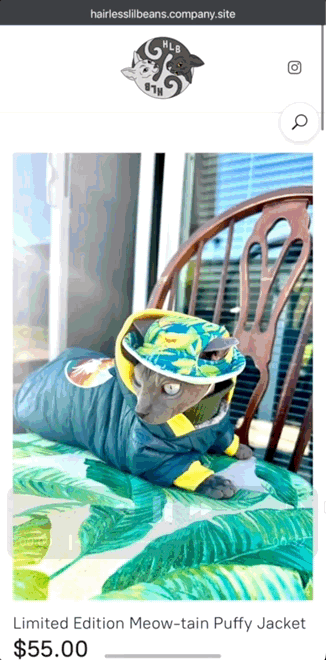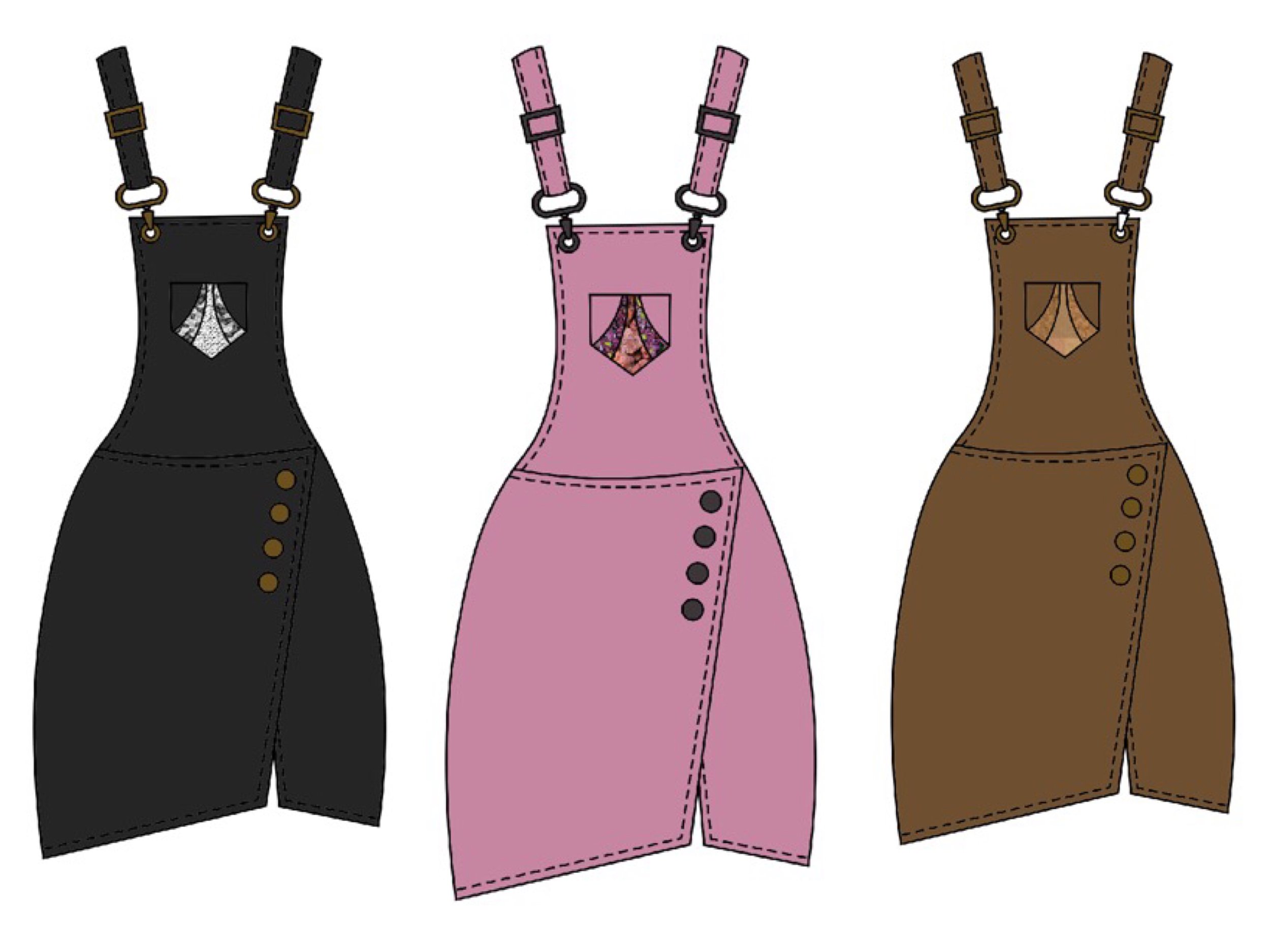HLB Gear & Ponovena
Clothing design, branding, and building a responsive website for two companies
HLB Gear
Designed a cat puffy jacket and leashes, and developed websites for both the blog and e-commerce platforms ・ 2022-2024
Overview
I led the design of cat puffy jackets and leashes. This involved creating detailed tech packs and collaborating closely with the factory, akin to UX designers' handoffs to engineering. I also developed a website for our adventure cat blog, sharing tips and promoting brands as influencers through the @hairlesslilbeans Instagram. Additionally, I built an e-commerce site to sell our custom-designed products, integrating branding, web design, and product management. Check it out:
Hairlesslilbeans Instagram
Objective
Our goal was to create a distinctive clothing line for cats, including puffy jackets and leashes, while effectively managing product design and production. We aimed to enhance our brand through a dedicated adventure cat blog and an e-commerce site, using our @hairlesslilbeans Instagram influence to share tips and promote our products.
Role
Founder, Clothing Designer, Product Designer, Visual Design, Brand Development
Key Results
Achieved 42 orders with a total gross revenue of $2,270.
Grew the Instagram account from 7,000 to 38,000 followers.
Recorded 1,702 views and 785 unique visitors on the blog.
Facilitated brand deals through the blog, resulting in an additional gross revenue of $10,000.
The Challenge
In a saturated pet apparel market, there is a lack of distinctive, high-quality, and fashionable clothing options for adventure-loving cats. While cat leashes serve all adventure cats, there is a specific need for puffy jackets designed to keep sphynx cats warm due to their lack of fur. Existing products often fail to address both functional needs and stylish design. Our challenge was to create a unique clothing line that meets these needs, develop a compelling brand identity, and establish a strong online presence to drive product sales and secure brand partnerships.
The Users
Adventurous cat owners who are enthusiastic about exploring the outdoors with their pets.
Newcomers to outdoor training, seeking guidance and support for their journey.
Sphynx cat owners needing specialized products like warm puffy jackets due to their cats' lack of fur.
Blog readers seeking practical tips and inspiration for training their cats and enhancing their outdoor experiences.
Customers looking for stylish and durable leashes during adventures.
The Process
Website Development:
We focused on creating a streamlined and user-friendly experience for purchasing products. To keep costs low as a startup, we designed a simple e-commerce site with essential features only. The website includes a FAQ section for shipping and returns, an About Us page introducing the owner and cats, and straightforward product listings. Customers can easily view product details, see photos, select colors and sizes, and complete their purchase with minimal friction.
For the blog, we utilized WordPress to build a site that aligns with our brand's aesthetic and functional needs. By customizing WordPress’s flexible structure, we ensured the blog is visually cohesive with our brand while providing a platform for sharing tips, stories, and promoting products effectively.
Product Development:
As a brand dedicated to cats, it was imperative that our product development met the specific needs of our feline customers. For the puffy jackets, we collaborated with PrideBites, a Shark Tank-winning company specializing in dog products. To keep costs manageable, we adapted one of their existing puffy designs to fit cats. I created a new pattern and included it in our tech pack, specifically editing the neck and hood aspects to better suit feline anatomy. The tech pack also included a step-by-step guide for PrideBites to produce the cat-specific jackets.
For the leashes, we worked with a separate factory that allowed for smaller production runs, accommodating our needs for flexibility. This factory produced 50 leashes per color-way, which was ideal for our startup. We provided a detailed tech pack with our design, color, and material choices, inclusive of our logo design, and instructions for manufacturing, ensuring each leash met our specifications.
Hood Pattern
Leash Tech Pack
Branding
Patch
Logo
Jacket
HLB Gear’s branding originates from our Instagram handle, @hairlesslilbeans, a playful nod to our sphynx cats and their distinctive toe beans. This playful and adventurous spirit extends into our branding elements.
For the puffy jacket icon, we drew inspiration from the concept of "headed to the meow-tains" reflecting the target audience of our products. The design features a cat over a mountain range, with heart-shaped sunglasses to evoke a sense of fun and inclusivity.
The color palette was carefully chosen to represent the outdoors and align with popular outdoor gear trends. These colors not only resonate with the adventurous theme but also complement our Instagram feed's aesthetic.
The logo incorporates both of our sphynx cats, Mochi and Chewy, in a yin-yang formation, inspired by their endearing habit of cuddling in this position.
Learnings
A clean, functional site helps in maintaining customer satisfaction and driving sales.
Effective collaboration with factories and detailed tech packs aided in adapting designs and ensuring precise production. Clear communication highlighting the importance of a thorough design handoff in achieving successful product outcomes.
Ensuring that the blog and e-commerce site maintained a cohesive brand identity was crucial for building trust and recognition.
Next Steps
Leverage insights to refine UX processes. Evaluate potential improvements to the e-commerce site, such as integrating customer reviews, offering a loyalty program, or adding interactive elements.
Apply learnings to explore new products and integrate user feedback to continually improve the overall user experience.
Develop targeted marketing strategies to reach new audiences and drive traffic. Explore collaborations, influencer partnerships, and advertising campaigns to grow our brand’s visibility and reach.
Ponovena
Designed a clothing line with six pieces, developed an e-commerce website, and managed the vending of those designs ・ 2018-2019
Overview
For Ponovena, we redesigned and rebranded our website to align with our new identity and effectively showcase a diverse 1,000-piece clothing line made from deadstock fabric. The updated site highlights the expanded product range and provides detailed insights into the design process, enhancing our connection with the audience.
Simultaneously, we developed a 6-piece clothing collection to complement our previous staple of custom overalls. This involved creating detailed tech packs as comprehensive instruction manuals for the cut and sew and fabric factories, ensuring accurate production of each design. Extensive collaboration was required to source hardware, fabrics, and tags, and to ensure the factories could accurately reproduce the designs from the samples, meeting our launch deadline.
Objective
The objective of this project was to modernize Ponovena’s online presence through a comprehensive rebranding and website redesign, while also expanding our product offerings with a new clothing line. This aimed to attract a wider audience, improve user engagement, and support the successful launch of a diverse collection by ensuring seamless design and production processes.
Role
Co-Founder, Clothing Designer, Product Designer, Visual Design, Brand Development
Key Results
Sold the entire 1,000-piece collection.
Vended at major events, including San Diego Burning Man Festival Market, Festival of Yoga & Healthy Living, Fashion Show at House of Blues, and Same Same But Different Festival.
Achieved a gross profit of $50,000 from the collection.
Attracted an average of 1,000 monthly website visitors, with spikes during sales and holidays.
The Challenge
Ponovena faced the challenge of expanding its product offerings and updating its brand identity to attract a wider audience. The task was to design a new 1,000-piece clothing line and overhaul the website to effectively present this new collection. Key issues included ensuring accurate production through detailed tech packs, managing effective factory collaboration, and enhancing the website to improve user engagement and support the launch of the expanded product range.
The Users
Our target users are individuals who likely have attended music festivals or fashion markets and appreciate unique fashion with a personal touch. They seek casual, everyday wear that maintains individuality and stands out from mainstream options. These users are environmentally conscious, favoring clothing made from deadstock recycled fabrics discarded by fast fashion. They are committed to supporting slow fashion and small businesses, valuing ethical practices and sustainability in their clothing choices.
The Process
We began by finalizing the six designs for our clothing line, creating and testing patterns, and iterating to produce samples for each design. To accommodate sizing variations, we partnered with a manufacturer to adjust the patterns from the sample size (S) to medium (M) and large (L), which was crucial for professional digitization for the cut and sew factory. We then developed a comprehensive tech pack with detailed instructions, including step-by-step cut and sew guidelines, specifications for hardware, and fabric colors and patterns.
The factory was given a six-month timeline to complete production. However, an unexpected flood at our fabric factory extended the timeline for fabric delivery to the cut and sew factory. We maintained regular communication with all partners to ensure our designs were prioritized and the project remained on track.
Concurrently, we redesigned our website to reflect the new branding, including a blog documenting the design and production process, a new landing page, and updated UI elements. We engaged our followers by sharing progress updates online to build anticipation and keep them informed about the launch.
Branding
Tag
Sizing Chart
Hero Image
Ponovena embarked on a transformative rebranding journey to reposition our clothing line from custom overalls and festival wear into a brand that appeals to a broader audience. Our reimagined vision focused on offering sustainable fashion crafted from deadstock fabric, designed for versatility and inclusivity.
Philosophy: Our new brand philosophy centered on the idea of "versatile clothing for the multifaceted woman." This encapsulated our commitment to inclusivity and diversity, allowing our garments to be accessible and appealing to a wide range of individuals. The phrase reflected our goal to design clothing that is not only functional and sustainable but also adaptable to different aspects of daily life.
Aesthetic: We chose pastel solid colors paired with patterned fabrics, like ikat, for unique pocket details. This combination created a visually appealing and adaptable look.
Collection Name and Concept: Our "Lazy Artist Collection" featured pieces designed to be as functional and stylish as an art smock. The collection includes our signature overalls, similar to a "smock," suitable for both creative and everyday wear.
We then created a line sheet to submit to buyers and retailers, to help pitch out collection. We ended up getting in to two stores!
Check out the Ponovena Line Sheet.
Some of the collection
Conclusion & Learnings
Ultimately, I decided to close Ponovena to pursue other interests. This experience provided me with valuable insights into managing and scaling a business, especially within the realm of UX and product design.
Key Learnings:
I learned the importance of scaling gradually and making calculated risks rather than taking on large, uncalculated financial commitments. The clothing line was my biggest venture, and the financial strain highlighted the need for careful planning and risk management.
Unforeseen challenges, such as a factory flood and the pandemic, impacted production and sales. This experience highlighted the importance of contingency planning and flexibility to address unexpected issues effectively.
Managing excess inventory required offering numerous promotions and discounts, which affected our profit margins. This taught me about the importance of strategic planning in product lifecycle management, pricing strategies, and aligning product design with market demand to prevent overstock situations.
While redesigning our website and blog, I didn’t keep a record of the visual design changes (which is why they aren’t shown here). I learned it is necessary to document and preserve design iterations. Maintaining a comprehensive history of design changes is crucial for understanding decision-making processes, justifying design choices, and showcasing work effectively.
































